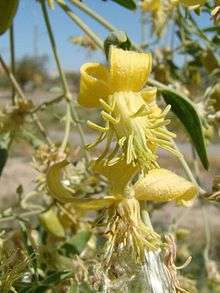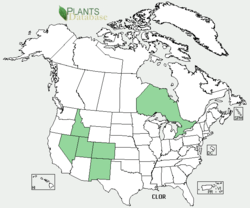Clematis orientalis
Clematis orientalis is a deciduous vine or scrambling shrub of the Clematis species, that originates from Asia and Central Europe. Brought to United States as an ornamental plant but escaped cultivation leading to its classification as a noxious weed in some states. Common names for C. orientalis include Chinese clematis, Oriental virginsbower, orange peel, and orange peel clematis.[1]
| Oriental virginsbower | |
|---|---|
.jpg) | |
| Scientific classification | |
| Kingdom: | Plantae |
| Clade: | Tracheophytes |
| Clade: | Angiosperms |
| Clade: | Eudicots |
| Order: | Ranunculales |
| Family: | Ranunculaceae |
| Genus: | Clematis |
| Species: | C. orientalis |
| Binomial name | |
| Clematis orientalis | |
Etymology
The name of the genus, Clematis, is a derivation of the Ancient Greek word "clématis", which means "climbing". This is a description of the tendency Clematis species show to be climbers.
Description

Clematis orientalis is a deciduous scrambling shrub that grows to attach to its environment by means of tendril-like stems.[2] It grows densely at a rate of least a meter per year.[2]
Stem
The stems are slender and tendril-like. It grows to heights of about 2–8 meters, with a thickness up to 7 cm. The stems are covered with gray-brown bark, with the inner bark being green.[1] The vines twine to rocks, other plants, and other things in its environment as it climbs.
Flower
C. orientalis flowers can grow in solitary or clusters in a cyme inflorescence. Most noticeable about the flower is the four yellow to yellow-orange sepals, which are often mistaken for its petals. The sepals are ovate-lanceolate to elliptic, wide-spreading and tend to curl back at its maturity. The sepals reaches widths of 2–3 cm and lengths of 6–9 cm.[3] No hair abaxial of sepal.[1]
The flower is hermaphroditic. The style is 3–10 cm long and remains attached to the achene, acting as its wings.
The flower has a strong fragrance.

Leaf
The leaves are pinnately compound, with 3 to 7 leaflets per leaf. The leaflets are coarsely-toothed to entire or ovate to linear-lanceolate and 1–5 cm long. The leaves have a gray-green color.[1] The leaves have an opposite arrangement on the stem.
Root
C. orientalis roots are weak and flexible with branching finer roots of tan to orange-tan coloring.[1]
Ecology
Clematis orientalis prefers well-drained soils. There is no preference of soil texture though does well on chalky soil. Can tolerate a range of alkaline or acidic soils.[4]
It has a preference of sunny habitats but have shown a tolerance for partially shaded areas. In the United States, it is found to be growing in shrublands, riverbanks, gullies, sand depressions, riparian forests in hot, dry valleys and desert and semidesert areas.[1] It can grow at elevations of 400 to 3,800 meters.[1]
Distribution

Clematis orientalis is native to Asia and Central Europe, specifically from Turkey through West Asia to the Korean Peninsula, south to Iran, and Northwest India.[1]
Originally planted in the United States as an ornamental plant but escaped its cultivation and naturalized to Nevada, Idaho, Utah, Colorado, New Mexico, Oregon, and Ontario of Canada.[2]
Reproduction

C. orientalis flowers appear from August to late September. The flowers and fruits are present at the same time. Pollination of the flowers are done by flies and bees.[1]
Seedheads are rounded clusters of fluffy winged seeds, resembling pom poms that disperse over winter and early spring.[2] The seeds are primarily dispersed by the wind.
Impact on habitat
Since C. orientalis is a vine, it grows and climb rocks, fences, and other plants. It has escaped cultivation and naturalized. It is classified as a noxious weed by some states. C. orientalis can cover young trees and bushes, killing them. Has ability to out compete native shrubby or herbaceous species.[4]
Uses
Clematis orientalis is primarily planted as an ornamental plant. It is also used as an antiseptic and refrigerant. Clematis orientalis has been documented to be used in Ancient Chinese medicine to treat dog bites and to treat ulcerated throats by gargling its infusion.[5]
References
- Francis, Frank K. United States. U.S. Department of Agriculture, Forest Service. Clematis orientalis L.. Web. <http://www.fs.fed.us/global/iitf/pdf/shrubs/Clematis orientalis.pdf>.
- King County (2012). "Noxious Weeds: Oriental clematis".
- Riedl, Harald, and Yasin J. Nasir. "Flora of Pakistan." EFloras. N.p., n.d. Web. 28 Apr 2012. <http://www.efloras.org/florataxon.aspx?flora_id=5&taxon_id=200007697>.
- Colorado. Colorado Department of Agriculture. Chinese Clematis. Web. <http://www.colorado.gov/cs/Satellite?blobcol=urldata&blobheader=application/pdf&blobkey=id&blobtable=MungoBlobs&blobwhere=1191392899595&ssbinary=true Archived 2013-04-12 at the Wayback Machine>.
- ."Clematis orientalis – L.." Plants For A Future . N.p., n.d. Web. 28 Apr 2012. <http://www.pfaf.org/user/Plant.aspx?LatinName=Clematis orientalis>.
External links
- Plants For A Future: Clematis orientalis - L.
- Kew Plant List
- USDA Profile
- IPNI Listing